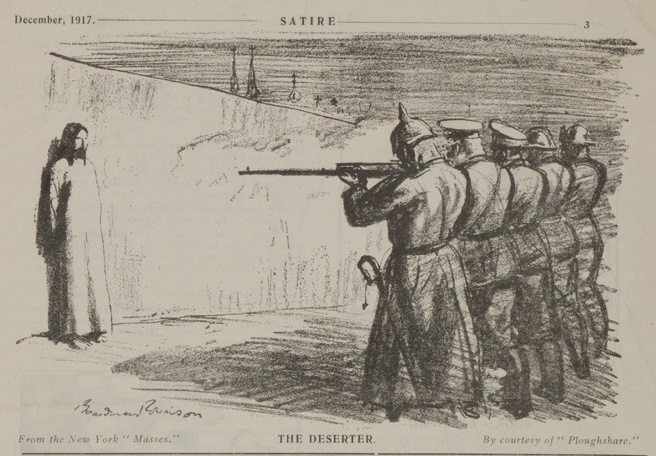|
Max Sandin
Max Sandin (June 3, 1889–September 14, 1971) was a painter and anti-war activist who was persecuted by the United States government during both World Wars for refusal to cooperate with military conscription. World War I When Sandin was drafted into the U.S. military during World War I, he declared himself a conscientious objector. The military would not accept this, on the grounds that his objection was political, not religious, in nature. Subsequently, for refusing to obey an order, Sandin was sentenced to be killed by firing squad. President Wilson commuted that sentence to imprisonment at Fort Leavenworth. World War II Sandin was again imprisoned for refusing to register for the draft in 1943. War Tax Resistance In 1943, Sandin began Tax Resistance, to refuse to pay taxes that would be destined for military spending. He continued to refuse for the rest of his life. In 1949, he joined the war tax resistance pledge of Peacemakers, the first non-sectarian organized war ... [...More Info...] [...Related Items...] OR: [Wikipedia] [Google] [Baidu] |
Conscientious Objector
A conscientious objector (often shortened to conchie) is an "individual who has claimed the right to refuse to perform military service" on the grounds of freedom of thought, conscience, or religion. The term has also been extended to objecting to working for the military–industrial complex due to a crisis of conscience. In some countries, conscientious objectors are assigned to an alternative civilian service as a substitute for conscription or military service. A number of organizations around the world celebrate the principle on May 15 as International Conscientious Objection Day. On March 8, 1995, the United Nations Commission on Human Rights resolution 1995/83 stated that "persons performing military service should not be excluded from the right to have conscientious objections to military service". This was re-affirmed on April 22, 1998, when resolution 1998/77 recognized that "persons lreadyperforming military service may ''develop'' conscientious objections". H ... [...More Info...] [...Related Items...] OR: [Wikipedia] [Google] [Baidu] |
Fort Leavenworth
Fort Leavenworth () is a United States Army installation located in Leavenworth County, Kansas, in the city of Leavenworth, Kansas, Leavenworth. Built in 1827, it is the second oldest active United States Army post west of Washington, D.C., and the oldest permanent settlement in Kansas. Fort Leavenworth has been historically known as the "Intellectual Center of the Army." During the country's Western United States, westward Manifest Destiny, expansion, Fort Leavenworth was a forward destination for thousands of soldiers, surveyors, immigrants, Native Americans in the United States, American Indians, preachers and settlers who passed through. Today, the garrison supports the United States Army Training and Doctrine Command, US Army Training and Doctrine Command (TRADOC) by managing and maintaining the home of the United States Army Combined Arms Center, US Army Combined Arms Center (CAC). CAC's mission involves leader development, collective training, and Army doctrine and batt ... [...More Info...] [...Related Items...] OR: [Wikipedia] [Google] [Baidu] |
Tax Resistance
Tax resistance is the refusal to pay tax because of opposition to the government that is imposing the tax, or to government policy, or as opposition to taxation in itself. Tax resistance is a form of direct action and, if in violation of the tax regulations, also a form of civil disobedience. Examples of tax resistance campaigns include those advocating home rule, such as the Salt March led by Mahatma Gandhi, and those promoting women's suffrage, such as the Women's Tax Resistance League. War tax resistance is the refusal to pay some or all taxes that pay for war, and may be practiced by conscientious objectors, pacifists, or those protesting against a particular war. Tax resisters are distinct from "tax protesters", who deny that the legal obligation to pay taxes exists or applies to them. Tax resisters may accept that some law commands them to pay taxes but they still choose to resist taxation. History The earliest and most widespread forms of taxation were the corvée and ... [...More Info...] [...Related Items...] OR: [Wikipedia] [Google] [Baidu] |
Peacemakers
Peacemakers was an American pacifist organization founded following a conference on "More Disciplined and Revolutionary Pacifist Activity" in Chicago in July 1948. Ernest and Marion Bromley and Juanita and Wally Nelson largely organized the group. The name “Peacemakers” was taken from a section of the Bible, the Beatitudes or Sermon on the Mount: "Blessed are the peacemakers, for they will be called children of God." The group’s organizational structure adopted a multidivisional organizational structure with a loose hierarchy, prioritizing local committees including but not limited to the Tax Refusal and Military Draft Refusal Committee. The Peacemakers were social anarchists whose organizational beliefs are largely attributed to Marxist philosophy. Peacemakers aimed to advocate nonviolent resistance in the service of peace. Organizational structure The Peacemakers differed from other pacifist and nonviolent resistance organizations in their emphasis on small-scale, loc ... [...More Info...] [...Related Items...] OR: [Wikipedia] [Google] [Baidu] |
United States Secret Service
The United States Secret Service (USSS or Secret Service) is a federal law enforcement agency under the Department of Homeland Security charged with conducting criminal investigations and protecting U.S. political leaders, their families, and visiting heads of state or government. Until 2003, the Secret Service was part of the Department of the Treasury, as the agency was founded in 1865 to combat the then-widespread counterfeiting of U.S. currency. Primary missions The Secret Service is mandated by Congress with two distinct and critical national security missions: protecting the nation's leaders and safeguarding the financial and critical infrastructure of the United States. Protective mission The Secret Service is tasked with ensuring the safety of the president of the United States, the vice president of the United States, the president-elect of the United States, the vice president-elect of the United States, and their immediate families; former presidents, their sp ... [...More Info...] [...Related Items...] OR: [Wikipedia] [Google] [Baidu] |


